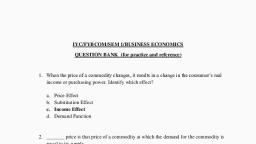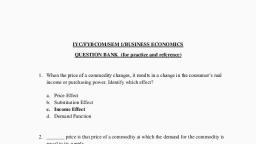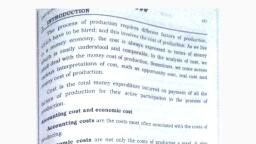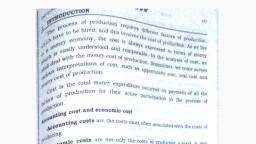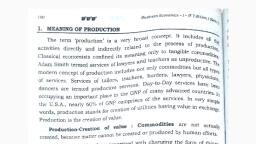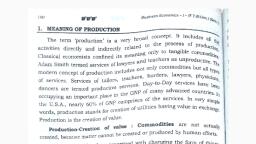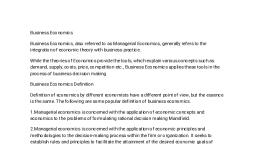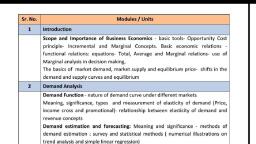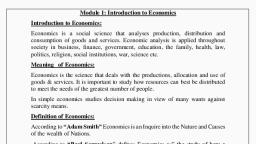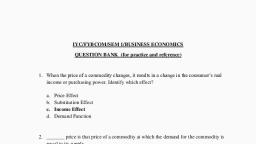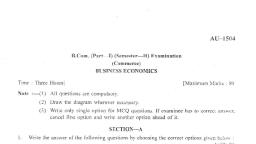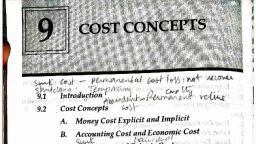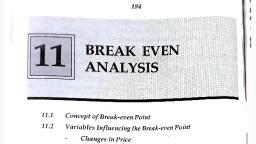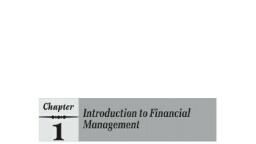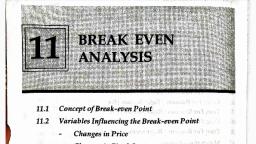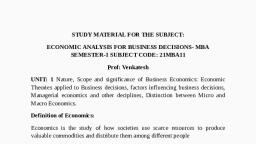Page 1 :
introduction, Modern business world is full of risks and uncertainties. The fact of, risks and uncertainties makes the function of decision-making and, forward planning complicated and further adds a different dimension to it., If the business executives have correct and perfect knowledge of the, future, they could formulate the plans about the future without any error, and without the need for their subsequent revision. But in the real world,, the business executives do not have complete and perfect information, about the future costs, sales, profits, market conditions etc. Therefore they, make decisions and formulate plans about the future on the basis of past, data, current information and the future estimates. As they implement, these plans over time, they come to know more facts which throw light on, their decisions and enable them to revise their plans and adopt a different, course of action. The business executives are thus engaged in a, continuous process of decision- making and forward planning through, uncertain future. Both decision-making and forward planning go hand-in-, hand and they are described as 'adjusting to uncertainty' by the, business economists., Definitions of Business Economics, Business economics as a part of economics has been defined, differently by different thinkers. These definitions reveal, on the one hand,, the nature of the subject and on the other, the relationship between, Economics and Business Economics. Some important definitions are given, below :, a) Milton H. Spencer and Louis Siegleman define business, economics as the "the integration of economic theory with business, practice for the purpose of facilitating decision-making and forward, planning by management"., b) According to Mac Nair and Meriam : "Business economics, consists of the use of economic modes of thought to analyse business, situation"., c) In words of James Bates and J. R. Parkinson : "Business, economics is the study of the behaviour of firms in theory and practice. It, is to some extent a study of the way in which firms behave in response to, changes in techniques, markets, economic structures, organisations,, habits and tests, and how they themselves bring about changes"., d) To, Pappas and Brigham : "Business economics is the application, of economic theory and methodology to business administration practice.", 1
Page 2 :
Business Economics - I- (F.Y.B.Com.) (Sem, e) Prof. Evan J. Douglas in his book "Business Economics., Theory, Practice and Problems" defined as : "Business economics is, concerned with the application of economic principles and methodologies, to the decision-making process within the firm or organisation under the, conditions of uncertainly. It seeks to establish rules and facilitates the, attainment of the desired economic goals of management. These economic, goals relate to costs, revenues and profits and are important within both, the business and non-business institutions"., f) According to Colberg, Forbrush and Whitaker : "Business, economics is primarily concerned with the applicability of economic, concepts and analysis to decisions made by business"., All these definitions reveal the importance of economic theories in, decision-making and forward planning. Business economics makes use of, the analytical tools of economic theory in solving business problems. A, business economist can become a far more helpful member of the, management group by virtue of his studies of economic analysis., Business economics is practical in nature. It is applied economics, to solve the problems faced by the business executives. It is, in fact, a, guide to make efficient use of resources for the realisation of the, objectives of the firm., 3. SCOPE OF BUSINESS ECONOMICS, Since business economics' has emerged as a new discipline, there is, no unanimity of opinion among the economists regarding its exact scope., The following topics have, however, been included in the scope of business, economics :, i) Subject-matter, ii) Normative or Positive Science., iii) Profit : The Central Concept in Managerial Economics, iv) Optimisation Principles, v) Business Economics and other Disciplines., Let us have detailed explanation of these points included in the scope, of business economics., i) Subject-Matter, The subject-matter of business economics includes the following, topics :, 2
Page 3 :
rtion, a) Demand Analysis and Forecasting, b) Cost and Production Analysis, c) Pricing Decisions, Policies and Practices, d) Profit Management, e) Capital Management, O Linear Programming and Theory of Games, a) Demand Analysis and Forecasting : A business firm is an, economic organisation engaged in transforming productive resources into, goods to be sold in the market. A major part of the business decisions, depends upon an accurate estimate of demand. A forecast of future sales, 1s necessary to serve as a guide to the management for preparing, production schedules and employing resources. This will also help the, management to maintain or strengthen its market position and enlarge its, profits. Demand analysis helps to identify the various factors that, influence the demand for the firm's product and provides guidelines to, manipulate the demand. Such factors which influence the demand are, called demand determinants. Demand analysis and forecasting occupy a, strategic place in business economics and cover topics such as demand, determinants, demand distinctions and demand forecasting., b) Cost and Production Analysis : An accurate cost and production, analysis is essential for profit, cost control and sound pricing policies and, practices. Cost estimates are very useful for the management decisions., The factors causing variations in cost estimates should be given clue, consideration if the management is to arrive at correct cost estimates so, essential for planning purposes. Since all factors determining cost are not, always known or controllable, an element of uncertainty exists in cost, calculation. Cost analysis and production analysis are interconnected., However, production analysis frequently proceeds in physical terms while, cost analysis proceeds in monetary terms. Cost and production analysis, cover such topics as cost concepts and classification, cost-out-put, relationships, economics and diseconomies of scale, production function, and cost control., c) Pricing Decisions, Policies and Practices : Since price is the, genesis of the revenue of the firm, it forms the most important area of, business economics. The success of the business firm depends largely on, the correctness of the pricing decision taken by it. Therefore, the business, manager has to take utmost care in pricing decisions. He has to take into, 3
Page 4 :
Business Economics-I-(F.Y.B.Com.) (Sem, account the price determination theories in order to arrive at correct prie., decisions. He should know fully the market- conditions, degree, competition prevailing in the market and the steps to be taken for sale, promotion. Pricing decisions, policies and practices cover such topics, price ermination in different types of markets, pricing methods, differential, pricing, product-line pricing and price forecasting., d) Profit Management : The primary aim of every business firm is to, earn as much profit as possible. In fact, the success of the firm is, measured in terms of profits that it has made and the rate of dividend that, it has declared. But there is an element of uncertainty about profits, because of variations in costs and revenues caused by internal and, external factors. Therefore, the firms have to work under the conditions of, uncertainties. Profit analysis would have been a very easy talk, in case the, future is certain and known., Hence, under conditions of uncertainties, profit planning becomes, absolutely necessary. Uncertainties are caused by such factors as, fluctuations in demand, changes in prices of inputs and products,, changes in the degree of competition, changes in technology and method, of production, changes in government policies, changes in social, political,, economic and environmental conditions etc. Therefore, profit planning and, its measurement constitute the most difficult area of business economics., Profit management covers such topics as nature and. measurement of, profit, profit policies and techniques of profit planning like break-even, analysis., e) Capital Management : Capital management implies planning and, control of capital expenditure. There are three problems of capital, management viz., accurate calculation of the profitability of capital, investment, choice of capital investment and optimal allocation of capital., Capital management is the most complex and trouble-some problem for, the management involving high level decisions. Since the business is full, of risks and uncertainties, capital investment requires utmost care., Relatively huge sums are involved and the problems relating to capital, investment are so complex that their disposal needs considerable time and, labour and top-level decisions. Capital management covers such topics as, cost of capital, rate of return and selection of projects., 4
Page 5 :
7, troduction, n Linear Programming and Theory of Games In recent years,, there is a trend towards integration of Business Economics and, Operations Research. Therefore, techniques such as Linear Programming,, Inventory Control, Theory of Games etc. have also conic to he regarded as, part of the business economics. In the words of G.P.S. Clarkson, "Since, Operations Research is devoted to the task of improving decision, behaviour, the scope of Business Economics can only be viewed as, including these activities and techniques"., li) Normative or Positive Economics, Economics is divided into two categories viz. positive economics and, normative economics. Positive economics tells the things as they are in the, world and hence it is descriptive in nature. But normative economics deals, with things as they ought to be or should be, and hence it is prescriptive, in nature., Business economics is normative rather than positive in character. In, other words, it is prescriptive rather than descriptive. It deals with future, planning, policy making, decision-making and how to make use of, economic principles in all these. It therefore involves value judgements. It, tells what aims and objectives ought to be pursued by a firm and how best, they should he achieved., iii) Profit : The Central Concept in Managerial Economics, The first and foremost objective of every business firm is profit-making., It tends to be the yard-stick to measure the success of a business. It is a, barometer of the efficiency, progress and stability of the business firm. It is, the acid test of ability and competence in business planning and, programming. It provides an incentive for endurance and expansion of the, business firm. It is a 'must' for the survival and continuance of the, business., But whether a business firm should aim at maximisation of profit or, Peter F Drucker, the world renowned, not is debatable. According to, management consultant, "The problem of any business is not, maximisation of profit but the achievement of sufficient profit to, cover the risks of economic activity and avoid loss". However, in, business economics, profit maximisation continues to be the objective of, the firm and the study of the firm in business economics has centered, round the concept of profit., 5
